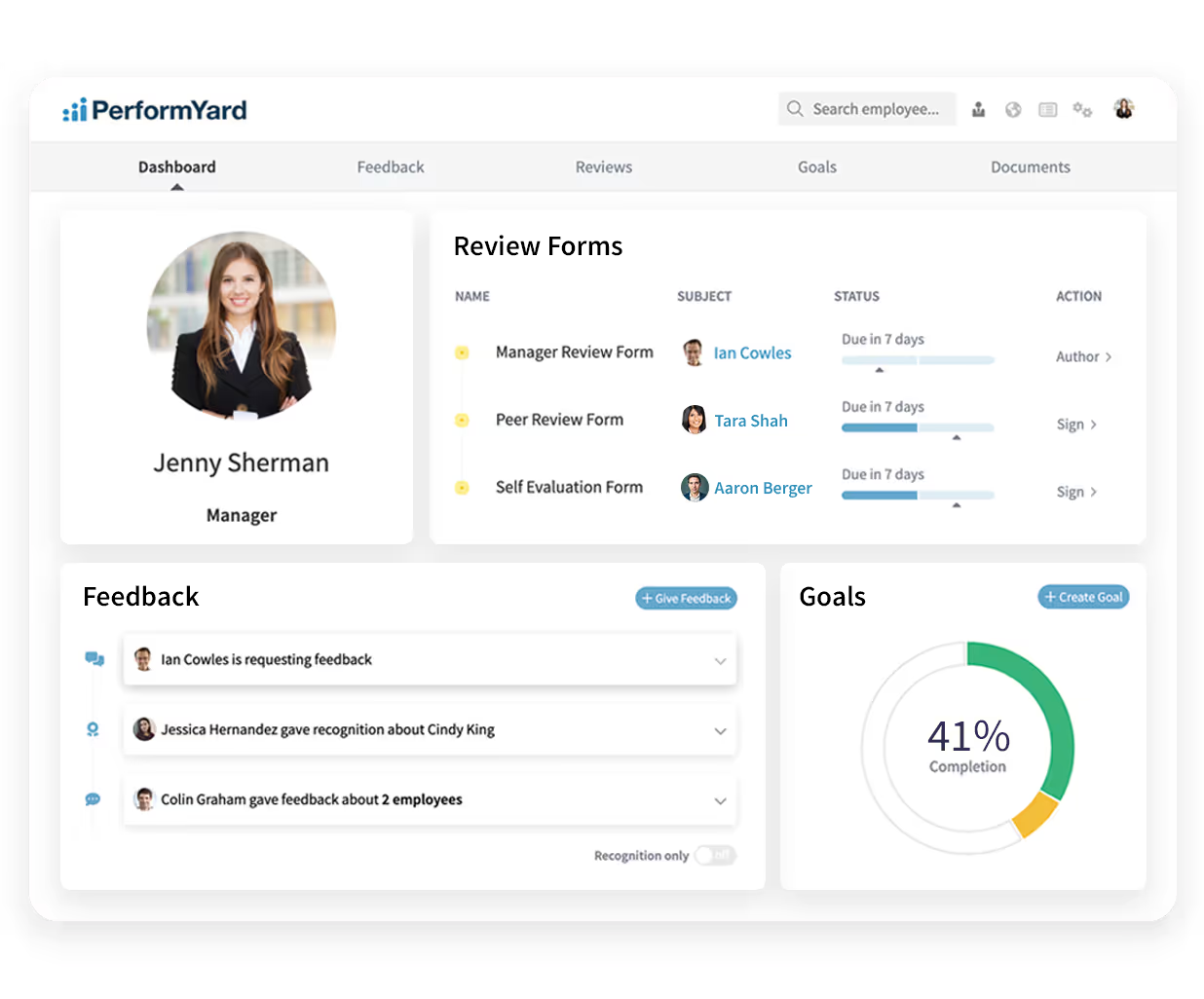How to Fix Low Performance Review Completion Rates
Perhaps more than any other business function, HR performance is hard to measure. How do you know a benefit is worth offering? Can you justify the ROI on that shiny new tool or initiative?
Questions like these plague many an HR leader.
But when you're dealing with hundreds of different personalities, how can you ensure everyone's taking the time to provide their feedback. And, importantly, how can you do it in a way that won't annoy them or turn them off from the process completely?
Departmental competitions rewarding managers with free parking spaces for 100% completion are great and all, but if there's a crack in the foundation of your performance management process, those attempts will still feel forced. Here are some subtle yet effective ways to get your performance review participation rates back on track.
Completing a performance review can be a daunting task for both managers and employees. The time it takes to finish a review significantly impacts completion rates and the overall efficacy of the performance management process. Understanding the current standard completion times and factors contributing to lengthy review processes is essential for Human Resource Professionals looking to streamline these evaluations.
Current Standard Completion Times for Performance Reviews
Performance reviews are often perceived as time-consuming, with many organizations adhering to an annual review cycle. On average, it can take managers about 17 to 210 hours per year to completely manage performance reviews for their teams. This encompasses preparing feedback, conducting the review meetings, and completing associated paperwork.
Factors Contributing to Time-Consuming Review Processes
Several factors contribute to why performance reviews are a joke for some employees and managers. Firstly, the bureaucratic nature of traditional performance reviews can make the process cumbersome. The necessity to fit reviews alongside regular work duties results in procrastination and rushed submissions. Ineffective templates and outdated software further delay the process.
Impact of Lengthy Performance Reviews on Completion Rates
When performance reviews are perceived as excessively lengthy, there is an increase in low performance review completion rates. Employees are often less engaged and may not see the value in detailed evaluations, thereby contributing to missed deadlines. This disengagement may lead some to wonder, as discussed in HBR performance reviews, whether annual reviews are still relevant.
PerformYard offers a strategic solution to address these challenges. By using dedicated performance management software, HR professionals can automate many steps within the review process. This not only reduces the time required to complete reviews but also ensures consistency and accuracy, ultimately leading to higher completion rates and better employee engagement.

How to Fix Low Completion Rates
1. Eliminate the Unnecessary
Raise your hand if you've heard this one before: "Sorry. I just don't have time for this right now."
It may sound like an excuse but in a world where managers typically spend 30-60% of their time on admin and meetings, it's not hard to imagine how they could come to resent the appraisal process, especially if it comes with a heavy paper trail. Research shows that managers spend up to 210 hours per year on performance management, and employees spend roughly 40 hours per year. For many employees, that's just too much.
If your employee appraisal process is overly complex, employees and managers alike will do everything they can to avoid it (even play hooky). Rather than loading an entire year's worth of feedback into one red-tape heavy annual review, consider some simple ways to deliver feedback more regularly, or try to adjust your appraisal forms to get the same or better insights with fewer questions.
If you're not sure what to keep and what to scrap, here's a quick guide to help walk you through.
2. Fight Cynicism with Purpose
If you get the feeling everyone dreads or even despises, your review process, you're probably right.
The reality is it's not just managers who are skeptical. A 2014 Deloitte report surveyed over 2,500 CEOs and HR leaders around the globe and found that 58% believe performance reviews aren't an effective use of time.
But if you can't see the value in the appraisal process, how can you expect anyone else to?
The good news is every review season is a fresh chance to reframe your approach. If you've recently implemented a lighter, faster review process, why not tell your employees about it? Tell them what you removed, what you kept and why. And if you're not sure where to start, sit down with your leaders and managers to find out what they want the review to accomplish. For example, do they want to encourage growth and development or raise the bar on autonomy and accountability? Performance management isn't a "set it and forget it" activity, but if it were, what would be the end game? What do you want to get out of it?
When your review process has a clear reason for existing, employees, managers and even the top-level players who are always "too busy" will find it much easier to get their reviews done.
3. Clearly Communicate Why and How
As HR managers, we take it for granted that this stuff's important. We've read the articles, we've seen the stats, we get it. But do your managers and employees know what's in it for them?
Fact is, 9 in 10 managers are dissatisfied with how their companies conduct annual performance reviews, which means they simply don't see the value in it. But if you've taken the time to develop a fair, focused, efficient process for evaluating employee performance, you should have no problem getting that buy-in.
Here are a few factors to include in your next announcement:
- The overarching goal of your performance management process
- A clear explanation of what the process was like then vs. now (if you've made a change)
- Real-world stats, examples and testimonials of how performance reviews help employees, managers and the business at large (feel free to use another company's example if you don't have your own yet)
- A step-by-step breakdown of how the process works and what the major deadlines are
- Tips for giving clear and compelling feedback
Once everyone's clear on the why, how and when, use an automated tool to take the pressure out of following up with managers who are still dragging their feet.
How to Make It Stick
At the end of the day, the purpose of your performance management process matters just as much as the process itself. A great way to ensure higher participation rates in the long-term is to involve your managers in designing the strategy to include the things they view as important.
What have they seen that does and doesn't work? In an ideal world, how much time would it take them to complete an appraisal? What would they get in return? Set a review process and schedule they can feel good about and use the right set of automated tools and systems to make the implementation as pain-free as possible.
Alternatives to Performance Reviews
As organizations evolve, the traditional performance review is increasingly seen as outdated. Insights from HR thought leaders and contemporary HR practices suggest that the once standard annual review process may no longer meet the dynamic needs of modern businesses. Companies like GE and IBM have moved towards more fluid and responsive feedback mechanisms.
Examples of Modern Alternatives to Traditional Performance Reviews
Many organizations are shifting away from rigid, annual reviews to more adaptive approaches that foster continuous growth and engagement. These alternatives often focus on real-time feedback and continuous dialogue. For instance, some companies employ continuous feedback systems that allow ongoing performance discussions, reducing the formality and constraints of annual reviews. This approach encourages a culture of ongoing development and immediacy in addressing performance concerns.
Introduction to the 'Three C's': Culture, Clarity, Consistency
The 'Three C's’—Culture, Clarity, and Consistency—reinforce modern performance management practices. Culture emphasizes creating an environment that encourages feedback and open communication. Clarity ensures that both managers and employees have a mutual understanding of performance expectations and objectives. Lastly, Consistency is vital in maintaining uniform review processes without repetitive inconsistencies that often plague traditional reviews.
Benefits of Adopting Alternative Feedback Mechanisms
Adopting these performance review alternatives offers numerous benefits, including enhanced engagement, improved employee satisfaction, and increased productivity. Continuous feedback mechanisms promote a proactive development approach, empowering employees to adjust and improve their performance in real-time. Moreover, less structured reviews can alleviate the administrative burden on HR departments, allowing for more strategic focus areas.
Implementing these alternatives with tools like PerformYard can streamline the process, ensuring these modern practices are effectively integrated into an organization's performance management system. Embracing these changes can not only avert the problems often associated with traditional methods but also align performance reviews with the fast-paced evolution of today's corporate landscape.



.jpg)

